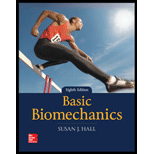
BASIC BIOMECHANICS
8th Edition
ISBN: 9781259913877
Author: Hall
Publisher: RENT MCG
expand_more
expand_more
format_list_bulleted
Concept explainers
Textbook Question
Chapter 4, Problem 10AP
If the anterior and posterior deltoids both insert at an angle of 60° on the humerus and each muscle produces a force of 100 N, how much force is acting perpendicular to the humerus? (Answer: 173.2 N)
Expert Solution & Answer
Want to see the full answer?
Check out a sample textbook solution
Chapter 4 Solutions
BASIC BIOMECHANICS
Ch. 4 - Prob. 1IPCh. 4 - Prob. 2IPCh. 4 - Prob. 3IPCh. 4 - Prob. 4IPCh. 4 - Prob. 5IPCh. 4 - Prob. 6IPCh. 4 - What kinds of fractures are produced only by...Ch. 4 - Prob. 8IPCh. 4 - In Problem 8, how much total stress is present on...Ch. 4 - Why are men less prone than women to vertebral...
Ch. 4 - Hypothesize about the way or ways in which each of...Ch. 4 - Prob. 2APCh. 4 - Prob. 3APCh. 4 - Hypothesize as to the ability of bone to resist...Ch. 4 - How are the bones of birds and fish adapted for...Ch. 4 - Prob. 6APCh. 4 - Hypothesize as to why men are less prone to...Ch. 4 - Prob. 8APCh. 4 - How much compression is exerted on the radius at...Ch. 4 - If the anterior and posterior deltoids both insert...
Knowledge Booster
Learn more about
Need a deep-dive on the concept behind this application? Look no further. Learn more about this topic, bioengineering and related others by exploring similar questions and additional content below.Similar questions
- Briefly define the types of joint movements available at a ball-and-socket joint.arrow_forwardMovement at the shoulder joint that moves the upper limb laterally away from the body is called ________. elevation eversion abduction lateral rotationarrow_forwardWatch this video (http://openstaxcollege.org/l/flexext) to learn more about the flexion and extension of the knee, as the femur both rolls and glides on the tibia to maintain stable contact between the bones in all knee positions. The patella glides along a groove on the anterior side of the distal femur. The collateral ligaments on the sides of the knee become tight in the fully extended position to help stabilize the knee. The posterior cruciate ligament supports the knee when flexed and the anterior cruciate ligament becomes tight when the knee comes into full extension to resist hyperextension. What are the ligaments that support the knee joint?arrow_forward
- Watch this video (http://openstaxcollege.org/l/anatomical) to learn about anatomical motions. What motions involve increasing or decreasing the angle of the foot at the ankle?arrow_forwardIn a general sense, how do skeletal muscles produce movement?arrow_forwardWhich statement is tine concerning the knee joint? The lateral meniscus is an intrinsic ligament located on the lateral side of the knee joint. Hyperextension is resisted by the posterior cruciate ligament. The anterior cruciate ligament supports the knee when it is flexed and weight bearing. The medial meniscus is attached to the tibial collateral ligament.arrow_forward
- What is the origin of the wrist flexors? the lateral epicondyle of the humerus the medial epicondyle of die humerus the carpal bones of the wrist the deltoid tuberosity of the humerusarrow_forwardDescribe the characteristic structures found at all synovial joints.arrow_forwardFigure 38.37 Which of the following statements about muscle contraction is true? The power stroke occurs when ATP is hydrolyzed to ADP and phosphate. The power stroke occurs when ADP and phosphate dissociate from the myosin head. The power stroke occurs when ADP and phosphate dissociate from the actin active site. The power stroke occurs when Ca2+ binds the calcium head.arrow_forward
- Which muscle pair plays a role in respiration? intertransversarii, interspinales semispinalis cervicis, semispinalis thoracis trapezius, rhomboids diaphragm, scalenearrow_forwardA high ankle sprain iis an injury caused by over stretching the ligaments connecting the tibia and fibula. What type of joint iis involved in this sprain? ball and socket gomphosis syndesmosis symphysisarrow_forwardWhich of the following supports body weight when sitting? iliac crest ischial nibeiosity ischiopubic ramus pubic bodyarrow_forward
arrow_back_ios
SEE MORE QUESTIONS
arrow_forward_ios
Recommended textbooks for you
 Human Physiology: From Cells to Systems (MindTap ...BiologyISBN:9781285866932Author:Lauralee SherwoodPublisher:Cengage Learning
Human Physiology: From Cells to Systems (MindTap ...BiologyISBN:9781285866932Author:Lauralee SherwoodPublisher:Cengage Learning Anatomy & PhysiologyBiologyISBN:9781938168130Author:Kelly A. Young, James A. Wise, Peter DeSaix, Dean H. Kruse, Brandon Poe, Eddie Johnson, Jody E. Johnson, Oksana Korol, J. Gordon Betts, Mark WomblePublisher:OpenStax College
Anatomy & PhysiologyBiologyISBN:9781938168130Author:Kelly A. Young, James A. Wise, Peter DeSaix, Dean H. Kruse, Brandon Poe, Eddie Johnson, Jody E. Johnson, Oksana Korol, J. Gordon Betts, Mark WomblePublisher:OpenStax College Principles Of Radiographic Imaging: An Art And A ...Health & NutritionISBN:9781337711067Author:Richard R. Carlton, Arlene M. Adler, Vesna BalacPublisher:Cengage Learning
Principles Of Radiographic Imaging: An Art And A ...Health & NutritionISBN:9781337711067Author:Richard R. Carlton, Arlene M. Adler, Vesna BalacPublisher:Cengage Learning- Lifetime Physical Fitness & WellnessHealth & NutritionISBN:9781337677509Author:HOEGERPublisher:Cengage

Human Physiology: From Cells to Systems (MindTap ...
Biology
ISBN:9781285866932
Author:Lauralee Sherwood
Publisher:Cengage Learning

Anatomy & Physiology
Biology
ISBN:9781938168130
Author:Kelly A. Young, James A. Wise, Peter DeSaix, Dean H. Kruse, Brandon Poe, Eddie Johnson, Jody E. Johnson, Oksana Korol, J. Gordon Betts, Mark Womble
Publisher:OpenStax College

Principles Of Radiographic Imaging: An Art And A ...
Health & Nutrition
ISBN:9781337711067
Author:Richard R. Carlton, Arlene M. Adler, Vesna Balac
Publisher:Cengage Learning

Lifetime Physical Fitness & Wellness
Health & Nutrition
ISBN:9781337677509
Author:HOEGER
Publisher:Cengage


GCSE PE - ANTAGONISTIC MUSCLE ACTION - Anatomy and Physiology (Skeletal and Muscular System - 1.5); Author: igpe_complete;https://www.youtube.com/watch?v=6hm_9jQRoO4;License: Standard Youtube License